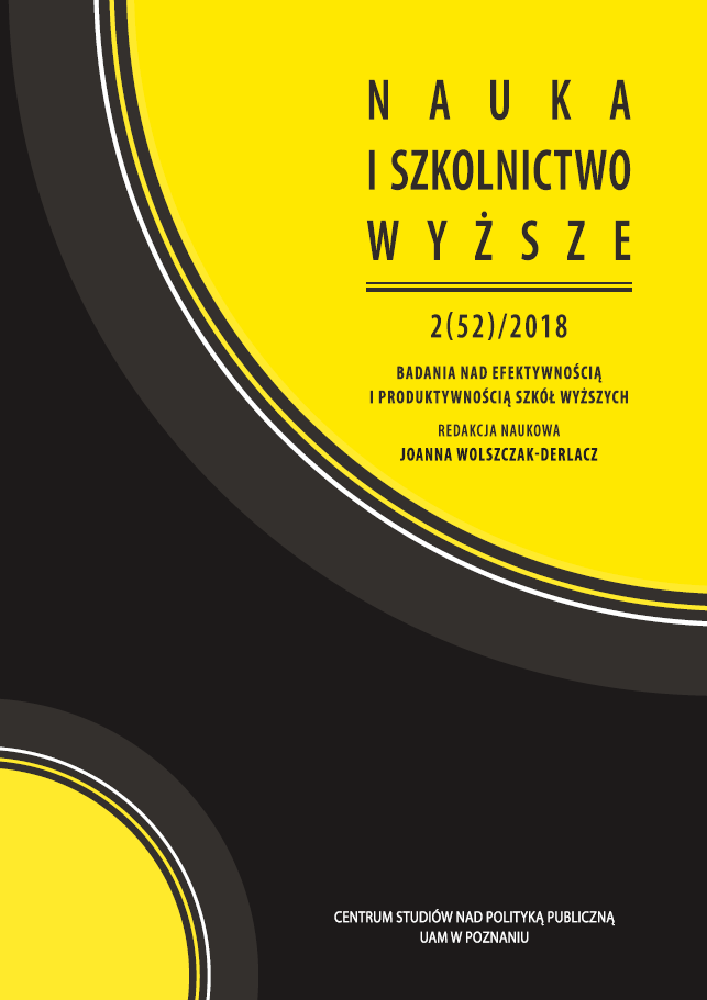Abstrakt
W artykule przeprowadzono analizę empiryczną efektywności szkół wyższych wraz z estymacją determinujących ją czynników. Próba badawcza składa się z uczelni z 19 krajów europejskich i obejmuje dane dla lat 2011–2014. Na podstawie nieparametrycznej metody DEA oszacowano wskaźniki efektywności, gdzie za nakłady przyjęto: wartość przychodów i liczbę nauczycieli akademickich. W wynikach działalności uczelni ujęto liczbę absolwentów oraz liczbę publikacji. Dodatkowo zbadano relację pomiędzy wybranymi zmiennymi a wskaźnikami efektywności. Rezultaty wskazują, że uczelnie większe i starsze są bardziej efektywne. Porównanie uczelni o tej samej wielkości i roku założenia pokazało, że te z nich, które mają większy odsetek pracowników niebędących nauczycielami akademickim i niższy udział przychodów zewnętrznych w budżecie, charakteryzują się niższą efektywnością.
Finansowanie
MNiSW
Bibliografia
Agasisti, T. (2011). Performances and spending efficiency in higher education: a European comparison through non-parametric approaches. Education Economics. 19(2): 199–224.
Agasisti, T., Catalano, G., Landoni, P. i Verganti, R. (2012). Evaluating the performance of academic departments: an analysis of research-related output efficiency. Research Evaluation. 21(1): 2–14.
Agasisti, T. i Pohl, C. (2012). Comparing German and Italian public universities: Convergence or divergence in the higher education landscape? Managerial and Decision Economics. 33(2): 71–85.
Baltaru, R. D. (2018). Do non-academic professionals enhance universities’ performance? Reputation vs. organisation. Studies in Higher Education: 1–14.
Bolli, T., Olivares, M., Bonaccorsi, A., Daraio, C., Aracil, A. G. i Lepori, B. (2016). The differential effects of competitive funding on the production frontier and the efficiency of universities. Economics of Education Review. 52: 91–104.
Bolli, T. i Somogyi, F. (2011). Do competitively acquired funds induce universities to increase productivity? Research Policy. 40: 136–147.
Bonaccorsi, A. i Daraio, C. (red.) (2007). Universities and Strategic Knowledge Creation: Specialization and Performance in Europe. Cheltenham–Northampton, MA: Edward Elgar Publishing.
Bonaccorsi, A., Daraio, C. i Simar, L. (2006). Advanced indicators of productivity of universities an application of robust nonparametric methods to Italian data. Scientometrics. 66(2): 389–410.
Brzezicki, Ł. (2018). Zestawienie badań polskiego szkolnictwa wyższego prowadzonych za pomocą metody DEA i indeksu Malmquista w latach 2005–2017. https://www.researchgate.net/profile/Lukasz_Brzezicki [30.06.2018].
Brzezicki, Ł. i Wolszczak-Derlacz, J. (2015). Pomiar efektywności kształcenia i produktywności publicznych szkół wyższych za pomocą nieparametrycznej metody DEA i indeksu Malmquista. Gospodarka Rynek Edukacja. 16(4): 13–19.
Butler, L. (2003). Explaining Australia’s increased share of ISI publications –The effects of a funding formula based on publication counts. Research Policy. 32(1): 143–15.
Cherchye, L. i Abeele, P. V. (2005). On research efficiency: A micro- analysis of Dutch university research in economics and business management. Research Policy. 34(4): 495–516.
Coelli, T. J., Rao, D. S. P., O'Donnell, C.J. i Battese, G.E. (2005). An introduction to efficiency and productivity analysis (2nd edition). New York: Springer.
Colbert, A., Levary, R.R. i Shaner, M.C. (2000). Determining the relative efficiency of MBA programs using DEA. European Journal of Operational Research. 125: 656–669.
Cooper, W. W., Seiford, L. M., Tone, K. i Zhu, J. (2007). Some models and measures for evaluating performances with DEA: past accomplishments and future prospects. Journal of Productivity Analysis. 28(3): 151–163.
Cooper, W.W., Seiford, L.M. i Zhu, J. (2004). Handbook on Data Envelopment Analysis. Hingham, MA: Kluwer Academic Publishers.
Ćwiąkała-Małys, A., Nowak, W. (2009). Wybrane metody pomiaru efektywności podmiotu gospodarczego. Wrocław: Wydawnictwo Uniwersytetu Wrocławskiego.
Daraio, C., Bonaccorsi, A., Geuna, A., Lepori, B., Bach, L., Bogetoft, P. i in. (2011). The European university landscape: A micro characterization based on evidence from the AQUAMETH project. Research Policy. 40(1): 148–164.
Daraio, C., Bonaccorsi i A. Simar, L. (2015a). Efficiency and economies of scale and specialization in European universities. A directional distance approach. Journal of Informetrics. 9: 430–448, D.
Daraio, C., Bonaccorsi, A. i Simar, L. (2015b). Rankings and University Performance: a Conditional Multidimensional Approach. European Journal of Operational Research. 244: 918–930.
Daraio, C. i Simar, L. (2007). Advanced robust and nonparametric methods in efficiency analysis: Methodology and applications. New York: Springer.
Daraio, C. i Glänzel, W. (2016). Grand challenges in data integration – State of the art and future perspectives: An introduction. Scientometrics. 108(1): 391–400.
ETER Final Quality Report (2017). https://www.eterproject.com/assets/pdf/ETER_quality_report_2017.pdf [9.04.2018].
Johnes, J. (2004). Efficiency measurement. W G. Johnes i J. Johnes (red.), International handbook on the economics of education (613–742). Edward Elgar Publishing Ltd: Cheltenham, UK.
Johnes, J. (2006a). Data envelopment analysis and its application to the measurement of efficiency in higher education. Economics of Education Review. 25(3): 273–288.
Johnes, J. (2006b). Measuring Teaching Efficiency in Higher Education: An Application of Data Envelopment Analysis to Economics Graduates from UK Universities 1993. European Journal of Operational Research. 174(1): 443–456.
Johnes, J. i Johnes, G. (1995). Research Funding and Performance in U.K. University Departments of Economics: A Frontier Analysis. Economics of Education Review. 14(3): 301–314.
Kempkes, G. i Pohl, C. (2010). The efficiency of German universities – Some evidence from nonparametric and parametric methods. Applied Economics. 42: 2063–2079.
Lepori, B., Ploder, M., Wagner-Schuster, D. i Gunnes, H. (2017) Report on the content and technical structure of the RISIS‐ETER facility: http://risis.eu/wpcontent/uploads/2017/10/RISIS_ETER_report.pdf [1.03.2018].
Martin, B. (2016). What’s happening to our universities? Prometheus. 34(1): 7–24.
Simar, L. i Wilson, P. (2000). A General Methodology for Bootstrapping in Non-parametric Frontier Models. Journal of Applied Statistics. 27(6): 779–802.
Wolszczak-Derlacz, J. (2013). Efektywność naukowa dydaktyczna i wdrożeniowa publicznych szkół wyższych w Polsce – analiza nieparametryczna. Gdańsk: Wydawnictwo Politechniki Gdańskiej.
Wolszczak-Derlacz, J. (2017). An evaluation and explanation of (in) efficiency in higher education institutions in Europe and the US with the application of two-stage semi-parametric DEA. Research Policy. 46(9): 1595–1605.
Wolszczak-Derlacz, J. i Parteka A. (2010). Produktywność naukowa wyższych szkół publicznych w Polsce – Bibliometryczna analiza porównawcza. Ernst & Young Polska.
Wolszczak-Derlacz, J. i Parteka A. (2011). Efficiency of European public higher education institutions: a two-stage multicountry approach. Scientometrics. 89: 887–917.
Worthington, A.C. (2001). An Empirical Survey of Frontier Efficiency Measurement Techniques In Education. Education Economics. 9(3): 245–268.
